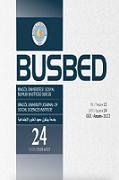MUHAMMED TÂHİR BİN ÂŞÛR’DA MAKÂSID VE MASLAHATIN KISIMLAR
SECTIONS OF MAQASID AND MASLAHAT IN MUHAMMAD TAHİR BİN ASHUR
Author(s): Yusuf BulutluSubject(s): Islam studies, Philosophy of Law, Sharia Law
Published by: Bingöl Üniversitesi Sosyal Bilimler Enstitüsü
Keywords: Mohammad b. Ashur; Parts of Maslahah; Purpose; Benefit; Parts of Maqâsid in Ibn Ashur;
Summary/Abstract: The subject of maqasid and maslahat, which started with Juveynî (d. 478) and Ghazali (d. 505), progressed with Shatibi (d. 790), and whose borders were tried to be drawn partially with Ibn Âşûr in the modern period, is important and has been tried to be classified from various angles. In the classical period, the concepts of maqasid and maslahat were subjected to different classifications and some classifications were generally accepted among the scholars. Juwayni made a beginning by classifying the interests, and then his student Ghazali divided the interests into three parts as essential, haji and tahsini. He also divided the essential interests into five basic purposes. This classification has become generally accepted and widespread. This issue, which has come to the fore again with Şâtıbi, has been divided into parts such as primary and natural, the taxpayer's purpose, and the Şârî's purpose, by keeping it in a different classification. In this article, it has been tried to examine what kind of classification Ibn Âşûr has tended in the division of maqâsid and maslahah after Shatibi and its background, and tried to determine and explain the divisions that Ibn Âşûr made over his work called Makâsıdu'ş-Şerîati'lİslamiyye. As a result, it has been seen that Tahir bin Âşûr reconsidered the issue of division of the maqasid, taking into account these classifications before him, and he worked on his purposes under two different headings as parts and varieties. It has been understood that he examined the parts of it in the form of kat'î zannî and kulli juz'i, and its varieties under the name of real and general customary purposes. He also divided the Maslahats into three parts in terms of needing him, concerning the ummah and being determined. When we look at the essence of Ibn Âşûr's logic of dividing maqâsid and maslahah, it has been determined that there is his desire to make kâsıd a branch of science and a method of ijtihad. As a matter of fact, this subject has been repeatedly mentioned at the beginning of his work and in many places.
Journal: Bingöl Üniversitesi Sosyal Bilimler Enstitüsü Dergisi (BUSBED)
- Issue Year: 12/2022
- Issue No: 24
- Page Range: 575-588
- Page Count: 14
- Language: Turkish

